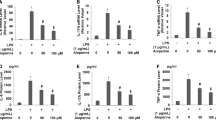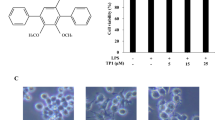Abstract
Chalcones, a group of phenolic compounds, exhibit potent anti-inflammatory properties. In the present study, we synthesized chalcone derivative, YL-I-108 ((E)-1-(2-methoxy-4,6-bis(methoxymethoxy)phenyl)-3-(3-nitrophenyl)prop-2-en-1-one), and examined its effect on the production of pro-inflammatory mediators. Treatment of RAW 264.7 macrophages with YL-I-108 potently inhibited nitrite production stimulated by LPS. YL-I-108 treatment also markedly inhibited expressions of inducible nitric oxide synthase (iNOS) and tumor necrosis factor-α (TNF-α). Treatment of cells with YL-I-108 significantly inhibited LPS-stimulated activator protein-1 (AP-1)-dependent reporter gene expression, whereas nuclear factor-κB (NF-κB) activity was not affected, indicating that down-regulation of iNOS expression by YL-I-108 is attributed by blockade of AP-1. In addition, YL-I-108 treatment led to an increase in heme oxygenase-1 (HO-1) mRNA and protein expression, accompanied with the increased expression of nuclear factor-erythroid 2-related factor 2 (Nrf2). Treatment with SnPP, a selective HO-1 inhibitor, reversed YL-I-108-mediated suppression of nitrite production, suggesting that HO-1 induction is implicated in the suppression of NO production by YL-I-108. In contrast, SnPP treatment did not reverse YL-I-108-mediated suppression of AP-1 activation, suggesting that AP-1 inhibition by YL-I-108 is independent of HO-1 induction. Together, these results indicate that YL-I-108 suppresses NO production in LPS-stimulated macrophages via simultaneous induction of HO-1 expression and blockade of AP-1 activation.
Similar content being viewed by others
References
Abuarqoub, H., Foresti, R., Green, C. J., and Motterlini, R. Heme oxygenase-1 mediates the anti-inflammatory actions of 2′-hydroxychalcone in RAW 264.7 murine macrophages. Am. J. Physiol. Cell. Physiol., 290, C1092–C1099 (2006).
Alcaraz, M. J., Vicente, A. M., Araico, A., Dominguez, J. N., Terencio, M. C., and Ferrandiz, M. L., Role of nuclear factor-kappaB and heme oxygenase-1 in the mechanism of action of an anti-inflammatory chalcone derivative in RAW 264.7 cells. Br. J. Pharmacol., 142, 1191–1199 (2004).
Ban, H. S., Suzuki, K., Lim, S. S., Jung, S. H., Lee, S., Ji, J., Lee, H. S., Lee, Y. S., Shin, K. H., and Ohuchi, K. Inhibition of lipopolysaccharide-induced expression of inducible nitric oxide synthase and tumor necrosis factor-alpha by 2′-hydroxychalcone derivatives in RAW 264.7 cells. Biochem. Pharmacol., 67, 1549–1557 (2004).
Batt, D. G., Goodman, R., Jones, D. G., Kerr, J. S., Mantegna, L. R., Mcallister, C., Newton, R. C., Nurnberg, S., Welch, P. K., and Covington, M. B. 2′-substituted chalcone derivatives as inhibitors of interleukin-1 biosynthesis. J. Med. Chem., 36, 1434–1442 (1993).
Diaz-Guerra, M. J., Velasco, M., Martin-Sanz, P., and Bosca, L., Evidence for common mechanisms in the transcriptional control of type II nitric oxide synthase in isolated hepatocytes. Requirement of NF-kappaB activation after stimulation with bacterial cell wall products and phorbol esters. J. Biol. Chem., 271, 30114–30120 (1996).
Foresti, R., Hoque, M., Monti, D., Green, C. J., and Motterlini, R., Differential activation of heme oxygenase-1 by chalcones and rosolic acid in endothelial cells. J. Pharmacol. Exp. Ther., 312, 686–693 (2005).
Hsieh, H. K., Lee, T. H., Wang, J. P., Wang, J. J., and Lin, C. N., Synthesis and anti-inflammatory effect of chalcones and related compounds. Pharm. Res., 15, 39–46 (1998).
Jeong, W. S., Jun, M., and Kong, A. N., Nrf2: a potential molecular target for cancer chemoprevention by natural compounds. Antioxid. Redox. Signal., 8, 99–106 (2006).
Kim, Y. H., Kim, J., Park, H., and Kim, H. P., Anti-inflammatory activity of the synthetic chalcone derivatives: inhibition of inducible nitric oxide synthase-catalyzed nitric oxide production from lipopolysaccharide-treated RAW 264.7 cells. Biol. Pharm. Bull., 30, 1450–1455 (2007).
Ko, H. H., Tsao, L. T., Yu, K. L., Liu, C. T., Wang, J. P., and Lin, C. N., Structure-activity relationship studies on chalcone derivatives. the potent inhibition of chemical mediators release. Bioorg. Med. Chem., 11, 105–111 (2003).
Kristof, A. S., Marks-Konczalik, J., and Moss, J., Mitogenactivated protein kinases mediate activator protein-1-dependent human inducible nitric-oxide synthase promoter activation. J. Biol. Chem., 276, 8445–8452 (2001).
Kwak, M. K., Itoh, K., Yamamoto, M., and Kensler, T. W., Enhanced expression of the transcription factor Nrf2 by cancer chemopreventive agents: role of antioxidant response element-like sequences in the nrf2 promoter. Mol. Cell. Biol., 22, 2883–2892 (2002).
Lee, C. J., Lee, S. S., Chen, S. C., Ho, F. M., and Lin, W. W., Oregonin inhibits lipopolysaccharide-induced iNOS gene transcription and upregulates HO-1 expression in macrophages and microglia. Br. J. Pharmacol., 146, 378–388 (2005).
Lee, S. H., Seo, G. S., Kim, J. Y., Jin, X. Y., Kim, H. D., and Sohn, D. H., Heme oxygenase 1 mediates anti-inflammatory effects of 2′,4′,6′-tris(methoxymethoxy) chalcone. Eur. J. Pharmacol., 532, 178–186 (2006).
Lee, S. H., Seo, G. S., and Sohn, D. H. Inhibition of lipopolysaccharide-induced expression of inducible nitric oxide synthase by butein in RAW 264.7 cells. Biochem. Biophys. Res. Commun., 323, 125–132 (2004).
Lee, S. H., Sohn, D. H., Jin, X. Y., Kim, S. W., Choi, S. C., and Seo, G. S., 2′,4′,6′-tris(methoxymethoxy) chalcone protects against trinitrobenzene sulfonic acid-induced colitis and blocks tumor necrosis factor-alpha-induced intestinal epithelial inflammation via heme oxygenase 1-dependent and independent pathways. Biochem. Pharmacol., 74, 870–880 (2007).
Lee, T. S. and Chau, L. Y., Heme oxygenase-1 mediates the anti-inflammatory effect of interleukin-10 in mice. Nat. Med., 8, 240–246 (2002).
Madan, B., Batra, S., and Ghosh, B., 2′-hydroxychalcone inhibits nuclear factor-kappaB and blocks tumor necrosis factor-alpha- and lipopolysaccharide-induced adhesion of neutrophils to human umbilical vein endothelial cells. Mol. Pharmacol., 58, 526–534 (2000).
Maines, M. D., The heme oxygenase system: a regulator of second messenger gases. Annu. Rev. Pharmacol. Toxicol., 37, 517–554 (1997).
Morse, D. and Choi, A. M., Heme oxygenase-1: the “emerging molecule“ has arrived. Am. J. Respir. Cell. Mol. Biol., 27, 8–16 (2002).
Nathan, C. and Xie, Q. W., Nitric oxide synthases: roles, tolls, and controls. Cell, 78, 915–918 (1994).
Nguyen, T., Sherratt, P. J., Huang, H. C., Yang, C. S., and Pickett, C. B., Increased protein stability as a mechanism that enhances Nrf2-mediated transcriptional activation of the antioxidant response element. Degradation of Nrf2 by the 26 S proteasome. J. Biol. Chem., 278, 4536–4541 (2003).
Nowakowska, Z., A review of anti-infective and anti-inflammatory chalcones. Eur. J. Med. Chem., 42, 125–137 (2007).
Otterbein, L. E., Soares, M. P., Yamashita, K., and Bach, F. H., Heme oxygenase-1: unleashing the protective properties of heme. Trends. Immunol., 24, 449–455 (2003).
Poss, K. D. and Tonegawa, S., Reduced stress defense in heme oxygenase 1-deficient cells. Proc. Natl. Acad. Sci. U. S. A., 94, 10925–10930 (1997).
Prawan, A., Kundu, J. K., and Surh, Y. J., Molecular basis of heme oxygenase-1 induction: implications for chemoprevention and chemoprotection. Antioxid. Redox. Signal., 7, 1688–1703 (2005).
Purdom-Dickinson, S. E., Sheveleva, E. V., Sun, H., and Chen, Q. M., Translational control of nrf2 protein in activation of antioxidant response by oxidants. Mol. Pharmacol., 72, 1074–1081 (2007).
Ryter, S. W. and Choi, A. M., Heme oxygenase-1: molecular mechanisms of gene expression in oxygen-related stress. Antioxid. Redox. Signal., 4, 625–632 (2002).
Ruan, R. S., Possible roles of nitric oxide in the physiology and pathophysiology of the mammalian cochlea. Ann. N Y Acad. Sci., 962, 260–274 (2002).
Sasaki, T., Takahashi, T., Maeshima, K., Shimizu, H., Toda, Y., Morimatsu, H., Takeuchi, M., Yokoyama, M., Akagi, R., and Morita, K., Heme arginate pretreatment attenuates pulmonary NF-kappaB and AP-1 activation induced by hemorrhagic shock via heme oxygenase-1 induction. Med. Chem., 2, 271–274 (2006).
Sawle, P., Foresti, R., Mann, B. E., Johnson, T. R., Green, C. J., and Motterlini, R., Carbon monoxide-releasing molecules (CO-RMs) attenuate the inflammatory response elicited by lipopolysaccharide in RAW264.7 murine macrophages. Br. J. Pharmacol., 145, 800–810 (2005).
Srisook, K., Kim, C., and Cha, Y. N., Molecular mechanisms involved in enhancing HO-1 expression: de-repression by heme and activation by Nrf2, the “one-two” punch. Antioxid. Redox. Signal., 7, 1674–1687 (2005).
White, K. A. and Marletta, M. A., Nitric oxide synthase is a cytochrome P-450 type hemoprotein. Biochemistry, 31, 6627–6631 (1992).
Yasui, Y., Nakamura, M., Onda, T., Uehara, T., Murata, S., Matsui, N., Fukuishi, N., Akagi, R., Suematsu, M., and Akagi, M., Heme oxygenase-1 inhibits cytokine production by activated mast cells. Biochem. Biophys. Res. Commun., 354, 485–490 (2007).
Author information
Authors and Affiliations
Corresponding author
Rights and permissions
About this article
Cite this article
Park, PH., Kim, H.S., Hur, J. et al. YL-I-108, a synthetic chalcone derivative, inhibits lipopolysaccharide-stimulated nitric oxide production in RAW 264.7 murine macrophages: Involvement of heme oxygenase-1 induction and blockade of activator protein-1. Arch. Pharm. Res. 32, 79–89 (2009). https://doi.org/10.1007/s12272-009-1121-5
Received:
Revised:
Accepted:
Published:
Issue Date:
DOI: https://doi.org/10.1007/s12272-009-1121-5




